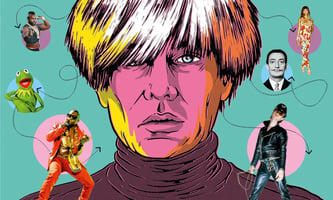A Glimpse Into His Interests and Hobbies Behind The Scenes “I don’t think less is more. More is...
Why Pop Art is Andy Warhol
In the 50s, the art world was a challenging, pretentious, and miserly place. Depressions and wars had made it seem unimportant, reducing its cultural force. There were too many critics, and not enough artists. After its many recent revolutions it was exhausted, and had over-intellectualised itself into a corner.

Painters like Mark Rothko and Jackson Pollock found themselves with the unenviable task of seeking some new territory that Picasso hadn’t already conquered. The result was abstract impressionism. Cubism and impressionism taken to an extreme. Simple blocks and streaks of paint applied to canvas. Art that said nothing, depicted nothing, and was purely form and colour. A landmark in 20th century art, but also something of a dead end.
Warhol arrived into this situation with little regard for what had gone before. He was unconcerned with critics and the baggage of the past – and if he did, it was only to turn it on its head. Instead of authenticity, he brought immediacy. Instead of craftsmanship, he brought vision. Instead of singular works of complexity, he brought a cohesive, identifiable aesthetic. Instead of the intense, driven, opinionated stereotype, he would be a playful, open-minded, and observant artist.

Everything the art world had once looked down its nose upon as vulgar (advertising, common culture, celebrity, etc) Warhol celebrated. He made art for the consumer, not the critic. The result was an entirely new definition of what art could and ought to be. Pop art.
Warhol’s art was ‘popular’ in the sense that it could be appreciated by everyone. It was as impactful and easy-to-understand as a poster, but still interesting and complex enough to hang in a museum. It utilised techniques of mass media and culture while also commenting on them. It turned America – specifically New York City – into the centre of global cultural life, stealing Europe’s importance not by beating them at their own game, but by changing the rules entirely. Like contemporaries The Beatles – purveyors of ‘pop’ music – it was artistically revolutionary while remaining accessible and enjoyable. During the cold war, his celebration of Americana was essential to America’s sense of itself as a place of glamor, excitement, and wealth as opposed to the grim and grey Soviet.

Andy Warhol did more than any other artist to turn the art world into the art business,’ said art critic Robert Hughes. Indeed, Warhol had not only bridged the worlds of mass media and high art, of advertising and aesthetic, of celebrity and the common man, he had proven to the art market that painters still had energy, vision, and something to say. In New York City, financial centre of the new global superpower, this faith was immediately translated into the currencies of this new world: Money, fame, and influence.
Undoubtedly, Warhol would have loved fractionalised art. It is an almost perfect encapsulation of his ideas: Art as valuable work, yet accessible to all. Unashamedly attached to commerce, but no less meaningful for it - perhaps even more so. An understanding that just as he could take a little piece of the Queen to participate in her immortal iconography, you can take a little piece of Warhol to do the same.



